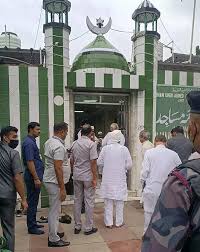Muslim clerics, Mohan Bhagwat agree on interfaith dialogue at meet

In a landmark meeting aimed at bridging gaps between communities, Rashtriya Swayamsevak Sangh (RSS) chief Mohan Bhagwat met with nearly 60 senior Muslim clerics, imams, and madrasa leaders on July 24, 2025, at Haryana Bhawan, New Delhi. The gathering, described by attendees as “constructive” and “forward-looking,” concluded with a significant decision: to launch structured, ongoing interfaith dialogues between Hindus and Muslims across India.
The event was convened by the All India Imam Organisation (AIIO), led by its head, Imam Umer Ahmed Ilyasi, to mark its 50th anniversary. The dialogue was also significant for the RSS, which is celebrating its 100th year. Senior RSS functionaries, including Krishna Gopal, Ramlal, and Indresh Kumar, attended the discussions, signaling the organization’s willingness to engage in meaningful conversations about social harmony.
The Purpose of the Meeting
The primary objective of the dialogue was to reduce misunderstandings, build trust, and create a framework for peaceful coexistence between the country’s major religious groups. Both sides agreed that India’s progress relies on unity and that religious polarization undermines national interest.
“Nation comes first,” said Bhagwat, reiterating the RSS’s stance that all Indians—regardless of religion—share a common cultural and historical identity. Imam Ilyasi echoed this sentiment, stating that the meeting was “an important step toward understanding and harmony,” emphasizing that constructive engagement is key to resolving societal tensions.
Key Outcomes and Agreements
The meeting resulted in a mutual commitment to establish formal dialogue platforms connecting religious leaders and institutions. These platforms will encourage conversations between mandirs and masjids, gurukuls and madrasas, and imams and pujaris. The goal is to eliminate stereotypes, foster respect, and encourage people-to-people contact at the grassroots level.
Both groups agreed that this effort must be continuous rather than a one-off event. A roadmap for future regional meetings and community outreach programs is expected to be announced soon. According to participants, dialogues will take place not just in major cities but also in smaller towns and rural areas where misunderstandings are often more pronounced.
Issues Raised During the Dialogue
While the meeting emphasized cooperation, Muslim clerics also highlighted several concerns affecting their communities, including:
- The Waqf Amendment Act, which has raised worries about the management of community properties.
- Instances of lynching and violence in the name of cow protection.
- The negative impact of derogatory labels such as “kafir” or “jihadi,” which fuel mistrust.
Although these issues were not the central agenda, they were acknowledged as underlying tensions that need resolution. Bhagwat and the RSS representatives assured the clerics that dialogue, rather than confrontation, is the way forward.
A Shift Towards Interfaith Engagement
The meeting reflects a broader effort by the RSS to reach out to different religious communities. This is not the first time Bhagwat has engaged with Muslim leaders. In the past, he met Muslim intellectuals, including former bureaucrats and academicians, to promote harmony. However, this gathering is notable for its scale and institutional backing, with over 60 clerics participating.
Imam Ilyasi noted that such interactions are crucial at the grassroots level. “Religious leaders shape the thinking of communities. If imams and pujaris speak the language of peace and unity, the public will follow,” he remarked.
Nation-First Narrative
A recurring theme throughout the meeting was the idea of shared national identity. Bhagwat reiterated that Hindus and Muslims have lived together for centuries, contributing to India’s cultural and spiritual heritage. He stressed that historical disputes or political differences should not divide communities today.
This narrative of “nation-first” is also central to the AIIO’s approach. Imam Ilyasi emphasized that India’s strength lies in its diversity and that religious leaders have a responsibility to uphold values of coexistence.
Challenges Ahead
While the meeting was hailed as a positive step, experts warn that dialogue alone cannot resolve deep-rooted issues. For the initiative to succeed, both communities must take proactive steps:
- Follow-through on Commitments – Regular meetings, rather than symbolic gestures, will be crucial.
- Grassroots Outreach – Involving local religious leaders, schools, and community organizations will ensure that the message of unity reaches ordinary citizens.
- Addressing Real Concerns – Issues such as communal violence, hate speech, and legal disputes must be addressed to build genuine trust.
Without concrete action, there is a risk that such initiatives could be dismissed as mere optics.
Broader Significance
This dialogue comes at a time when India faces increasing social polarization. In recent years, controversies around religious places, personal laws, and cultural practices have heightened tensions. The decision by Bhagwat and Muslim clerics to collaborate on building bridges rather than walls is therefore significant.
Analysts view this as a strategic move by the RSS, which has often been perceived as antagonistic to Muslim interests. By engaging openly with Muslim leaders, the organization signals its intent to move beyond historical prejudices and foster an inclusive narrative of Indian identity.
The Road Ahead
Looking forward, the success of this initiative will depend on the sincerity and persistence of both parties. Planned follow-up meetings are expected to focus on concrete projects, such as joint cultural events, interfaith educational programs, and community service initiatives.
Furthermore, efforts may extend to schools, colleges, and local organizations, where young people from different faiths can participate in dialogue and learn about shared values. Such initiatives, if implemented well, could help shape a generation that prioritizes unity over division.
Conclusion
The July 2025 meeting between Mohan Bhagwat and Muslim clerics marks a pivotal moment in India’s interfaith relations. By agreeing to launch structured dialogue, both sides have taken a symbolic and practical step toward harmony. While challenges remain, this initiative demonstrates that cooperation is possible when leaders choose understanding over confrontation.
If sustained and expanded, this interfaith dialogue could serve as a model for communal harmony, strengthening India’s social fabric and reaffirming the principle that unity in diversity is the nation’s greatest strength.






